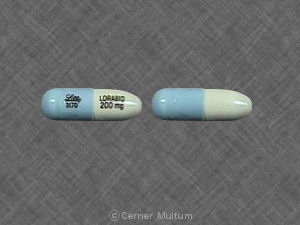Loracarbef Dosage
Applies to the following strengths: 200 mg; 400 mg; 100 mg/5 mL; 200 mg/5 mL
Usual Adult Dose for:
- Bronchitis
- Cystitis
- Pneumonia
- Pyelonephritis
- Sinusitis
- Skin or Soft Tissue Infection
- Tonsillitis/Pharyngitis
- Upper Respiratory Tract Infection
Usual Pediatric Dose for:
Additional dosage information:
Usual Adult Dose for Bronchitis
Secondary bacterial infection of acute bronchitis: 200 to 400 mg orally every 12 hours for 7 days
Acute bacterial exacerbation of chronic bronchitis: 400 mg orally every 12 hours for 7 days
Usual Adult Dose for Cystitis
Uncomplicated: 200 mg orally every 24 hours for 7 days
Usual Adult Dose for Pneumonia
Mild to moderate: 400 mg orally every 12 hours for 14 days
Usual Adult Dose for Pyelonephritis
Uncomplicated: 400 mg orally every 12 hours for 14 days
Usual Adult Dose for Sinusitis
400 mg orally every 12 hours for 10 days
Usual Adult Dose for Skin or Soft Tissue Infection
Uncomplicated: 200 mg orally every 12 hours for 7 days
Usual Adult Dose for Tonsillitis/Pharyngitis
200 mg orally every 12 hours for 10 days
Usual Adult Dose for Upper Respiratory Tract Infection
Mild to moderate: 200 to 400 mg orally every 12 hours for approximately 7 to 10 days, depending on the nature and severity of the infection
Usual Pediatric Dose for Otitis Media
6 months to 12 years: 15 mg/kg of the suspension orally every 12 hours for 10 days, not to exceed 800 mg/24 hours
Usual Pediatric Dose for Sinusitis
6 months to 12 years: 15 mg/kg orally every 12 hours for 10 days, not to exceed 800 mg/day
13 years or older: 400 mg orally every 12 hours for 10 days
Usual Pediatric Dose for Skin or Soft Tissue Infection
6 months to 12 years: 7.5 mg/kg orally every 12 hours for 7 days, not to exceed 400 mg/24 hours
13 years or older: 200 mg orally every 12 hours for 7 days
Usual Pediatric Dose for Impetigo
6 months to 12 years: 7.5 mg/kg orally every 12 hours for 7 days, not to exceed 400 mg/24 hours
13 years or older: 200 mg orally every 12 hours for 7 days
Usual Pediatric Dose for Tonsillitis/Pharyngitis
6 months to 12 years: 7.5 mg/kg orally every 12 hours for 10 days, not to exceed 400 mg/24 hours
13 years or older: 200 mg orally every 12 hours for 10 days
Renal Dose Adjustments
CrCl 10 to 49 mL/min: The normal dose may be given at twice the dosing interval, or half the normal dose may be given at the usual dosage interval
CrCl 9 mL/min or less: The normal dose may be given every 3 to 5 days
Liver Dose Adjustments
No adjustment recommended
Precautions
Clostridium difficile associated diarrhea (CDAD) has been reported with almost all antibiotics and may potentially be life-threatening. Therefore, it is important to consider this diagnosis in patients who present with diarrhea following loracarbef therapy. Mild cases generally improve with discontinuation of the drug, while severe cases may require supportive therapy and treatment with an antimicrobial agent effective against C difficile. Hypertoxin producing strains of C difficile cause increased morbidity and mortality; these infections can be resistant to antimicrobial treatment and may necessitate colectomy.
Beta-lactam antibiotics may be associated with a fall in prothrombin activity. Risk factors include renal or hepatic impairment, poor nutritional state, a protracted course of antimicrobial therapy, and chronic anticoagulation therapy. Prothrombin times should be monitored and vitamin K therapy initiated if indicated.
Serious and occasionally fatal hypersensitivity reactions have been reported with antibiotics. The drug should be discontinued immediately at the first appearance of a skin rash or other signs of hypersensitivity. Severe, acute hypersensitivity reactions may require treatment with epinephrine and other resuscitative measures including oxygen, intravenous fluids, antihistamines, corticosteroids, cardiovascular support and airway management as clinically indicated.
Some beta-lactams have been associated with seizures in renally impaired patients with elevated serum concentrations. The drug should be discontinued if seizures occur. Renal function should be monitored, especially in elderly patients. Caution is recommended in patients concomitantly being treated with potent diuretics.
Loracarbef capsules should not be substituted for the suspension in the treatment of otitis media, due to differences in absorption and plasma concentrations.
Safety and efficacy have not been established in infants less than 6 months old.
Dialysis
Patients on hemodialysis should receive another dose following dialysis.
Other Comments
Loracarbef should be taken at least 1 hour before or 2 hours after eating.
Unused portions of the suspension should be discarded after 14 days.
More about loracarbef
- Check interactions
- Compare alternatives
- Reviews (1)
- Side effects
- During pregnancy
- Drug class: second generation cephalosporins
- Breastfeeding
Patient resources
Other brands
Professional resources
Other brands
Related treatment guides
Further information
Always consult your healthcare provider to ensure the information displayed on this page applies to your personal circumstances.


